Downscaling Regional Crop Yields to Local Scale Using Remote Sensing
Abstract
1. Introduction
2. Materials and Methods
2.1. Study District and Crops
2.2. Satellite Datasets
2.3. Methodology
2.3.1. Pre-Processing of Satellite Data
EVI Time-Series Filtering
2.3.2. Crop Area Identification
Land Cover Image
2.3.3. Disaggregation of District Yield Statistics
3. Results
3.1. Crop Mapping
3.2. Disaggregated Crop Yield Map
4. Discussion
5. Conclusions
Author Contributions
Funding
Acknowledgments
Conflicts of Interest
References
- Aggarwal, P.K.; Chand, R.; Bhutani, A.; Kumar, V.; Goel, S.K.; Rao, K.N.; Poddar, M.K.; Sud, U.C.; Krishna Murthy, Y.V.N.; Ray, S.S.; et al. Report of the Task Force on Enhancing Technology Use in Agriculture Insurance; CMFRI: Kochi, India, 2016. [Google Scholar]
- Gangopadhyay, P.K.; Khatri-Chhetri, A.; Shirsath, P.B.; Aggarwal, P.K. Spatial targeting of ICT-based weather and agro-advisory services for climate risk management in agriculture. Clim. Chang. 2019, 154, 242–256. [Google Scholar] [CrossRef]
- Yeh, H.; Lee, C.; Hsu, K.; Chang, P. GIS for the assesment of the groundwater recharge potential zone. Environ. Geol. 2009, 58, 185–195. [Google Scholar] [CrossRef]
- Shelia, V.; Hansen, J.; Sharda, V.; Porter, C.; Aggarwal, P.; Wilkerson, C.J.; Hoogenboom, G. A multi-scale and multi-model gridded framework for forecasting crop production, risk analysis, and climate change impact studies. Environ. Model. Softw. 2019, 115, 144–154. [Google Scholar] [CrossRef]
- Gyawali, D.R.; Shirsath, P.B.; Kanel, D.; Burja, K.; Arun, K.C.; Aggarwal, P.K.; Hansen, J.W.; Rose, A. Inseason Crop Yield Forecasting for Early Warning Planning of Food Security Using Ccafs Regional Agricultural Forecasting Toolbox (Craft) in Nepal; CGIAR Research Program on Climate Change, Agriculture and Food Security (CCAFS): Wageningen, The Netherlands, 2018. [Google Scholar]
- Cantelaube, P.; Terres, J.M. Seasonal weather forecasts for crop yield modelling in Europe. Tellus A Dyn. Meteorol. Oceanogr. 2005, 57, 476–487. [Google Scholar] [CrossRef]
- Motha, R.P. Agricultural Drought: USDA Perspectives; Drought Mitigation Center Faculty Publications: Reston, Virginia, USA, 2011. [Google Scholar]
- Aggarwal, P.K.; Banerjee, B.; Daryaei, M.G.; Bhatia, A.; Bala, A.; Rani, S.; Chander, S.; Pathak, H.; Kalra, N. InfoCrop: A dynamic simulation model for the assessment of crop yields, losses due to pests, and environmental impact of agro-ecosystems in tropical environments. II. Performance of the model. Agric. Syst. 2006, 89, 47–67. [Google Scholar] [CrossRef]
- Aggarwal, P.K.; Kalra, N.; Chander, S.; Pathak, H. InfoCrop: A dynamic simulation model for the assessment of crop yields, losses due to pests, and environmental impact of agro-ecosystems in tropical environments. I. Model description. Agric. Syst. 2006, 89, 1–25. [Google Scholar] [CrossRef]
- Byjesh, K.; Kumar, S.N.; Aggarwal, P.K. Simulating impacts, potential adaptation and vulnerability of maize to climate change in India. Mitig. Adapt. Strateg. Glob. Chang. 2010, 15, 413–431. [Google Scholar] [CrossRef]
- Kumar, S.N.; Aggarwal, P.K.; Saxena, R.; Rani, S.; Jain, S.; Chauhan, N. An Assessment of Regional Vulnerability of Rice to Climate Change in India. Climatic Chang. 2013, 118, 683–699. [Google Scholar]
- Timsina, J.; Godwin, D.; Humphreys, E.; Kukal, S.S.; Smith, D. Evaluation of options for increasing yield and water productivity of wheat in Punjab, India using the DSSAT-CSM-CERES-Wheat model. Agric. Water Manag. 2008, 95, 1099–1110. [Google Scholar] [CrossRef]
- Subash, N.; Ram Mohan, H.S. Evaluation of the impact of climatic trends and variability in rice-wheat system productivity using Cropping System Model DSSAT over the Indo-Gangetic Plains of India. Agric. For. Meteorol. 2012, 164, 71–81. [Google Scholar] [CrossRef]
- Mohanty, M.; Probert, M.E.; Reddy, K.S.; Dalal, R.C.; Mishra, A.K.; Subba Rao, A.; Singh, M.; Menzies, N.W. Simulating soybean-wheat cropping system: APSIM model parameterization and validation. Agric. Ecosyst. Environ. 2012, 152, 68–78. [Google Scholar] [CrossRef]
- Singh, P.K.; Singh, K.K.; Bhan, S.C.; Baxla, A.K.; Singh, S.; Rathore, L.S.; Gupta, A. Impact of projected climate change on rice (Oryza sativa L.) yield using CERES-rice model in different agroclimatic zones of India. Curr. Sci. 2017, 112, 108–115. [Google Scholar] [CrossRef]
- Jones, J.; Hoogenboom, G.; Porter, C.; Boote, K.; Batchelor, W.; Hunt, L.; Wilkens, P.; Singh, U.; Gijsman, A.; Ritchie, J. The DSSAT cropping system model. Eur. J. Agron. 2003, 18, 235–265. [Google Scholar] [CrossRef]
- Singh, A.K.; Tripathy, R.; Chopra, U.K. Evaluation of CERES-Wheat and CropSyst models for water-nitrogen interactions in wheat crop. Agric. Water Manag. 2008, 95, 776–786. [Google Scholar] [CrossRef]
- Sudhir-Yadav, S.; Li, T.; Humphreys, E.; Gill, G.; Kukal, S.S. Evaluation and application of ORYZA2000 for irrigation scheduling of puddled transplanted rice in north west India. Field Crops Res. 2011, 122, 104–117. [Google Scholar] [CrossRef]
- Dadhwal, V.K.; Sehgal, V.K.; Singh, R.P.; Rajak, D.R. Wheat yield modelling using satellite remote sensing with weather data: Recent Indian experience. Mausam 2003, 54, 253–262. [Google Scholar]
- Becker-Reshef, I.; Justice, C.; Sullivan, M.; Vermote, E.; Tucker, C.; Anyamba, A.; Small, J.; Pak, E.; Masuoka, E.; Schmaltz, J.; et al. Monitoring Global Croplands with Coarse Resolution Earth Observations: The Global Agriculture Monitoring (GLAM) Project. Remote Sens. 2010, 2, 1589–1609. [Google Scholar] [CrossRef]
- Lobell, D.B.; Burke, M.B. On the use of statistical models to predict crop yield responses to climate change. Agric. For. Meteorol. 2010, 150, 1143–1152. [Google Scholar] [CrossRef]
- Burke, M.; Lobell, D.B. Satellite-based assessment of yield variation and its determinants in smallholder African systems. Proc. Natl. Acad. Sci. USA 2017, 114, 2189–2194. [Google Scholar] [CrossRef]
- Jin, X.; Kumar, L.; Li, Z.; Feng, H.; Xu, X.; Yang, G.; Wang, J. A review of data assimilation of remote sensing and crop models. Eur. J. Agron. 2018, 92, 141–152. [Google Scholar] [CrossRef]
- Weiss, M.; Jacob, F.; Duveiller, G. Remote sensing for agricultural applications: A meta-review. Remote Sens. Environ. 2020, 236, 111402. [Google Scholar] [CrossRef]
- Lobell, D.B.; Azzari, G. Satellite detection of rising maize yield heterogeneity in the U.S. Midwest. Environ. Res. Lett. 2017, 12, 014014. [Google Scholar] [CrossRef]
- Azzari, G.; Jain, M.; Lobell, D.B. Towards fine resolution global maps of crop yields: Testing multiple methods and satellites in three countries. Remote Sens. Environ. 2017, 202, 129–141. [Google Scholar] [CrossRef]
- Lobell, D.B.; Thau, D.; Seifert, C.; Engle, E.; Little, B. A scalable satellite-based crop yield mapper. Remote Sens. Environ. 2015, 164, 324–333. [Google Scholar] [CrossRef]
- Chakrabarti, S.; Bongiovanni, T.; Judge, J.; Zotarelli, L.; Bayer, C. Assimilation of SMOS Soil Moisture for Quantifying Drought Impacts on Crop Yield in Agricultural Regions. IEEE J. Sel. Top. Appl. Earth Obs. Remote Sens. 2014, 7, 3867–3879. [Google Scholar] [CrossRef]
- Ines, A.V.M.; Das, N.N.; Hansen, J.W.; Njoku, E.G. Assimilation of remotely sensed soil moisture and vegetation with a crop simulation model for maize yield prediction. Remote Sens. Environ. 2013, 138, 149–164. [Google Scholar] [CrossRef]
- Nearing, G.S.; Crow, W.T.; Thorp, K.R.; Moran, M.S.; Reichle, R.H.; Gupta, H.V. Assimilating remote sensing observations of leaf area index and soil moisture for wheat yield estimates: An observing system simulation experiment. Water Resour. Res. 2012, 48. [Google Scholar] [CrossRef]
- Gao, X.; Huete, A.R.; Ni, W.; Miura, T. Optical–Biophysical Relationships of Vegetation Spectra without Background Contamination. Remote Sens. Environ. 2000, 74, 609–620. [Google Scholar] [CrossRef]
- Chen, X.; Vierling, L.; Rowell, E.; DeFelice, T. Using lidar and effective LAI data to evaluate IKONOS and Landsat 7 ETM+ vegetation cover estimates in a ponderosa pine forest. Remote Sens. Environ. 2004, 91, 14–26. [Google Scholar] [CrossRef]
- Lovell, J.L.; Graetz, R.D. Filtering Pathfinder AVHRR Land NDVI data for Australia. Int. J. Remote Sens. 2001, 22, 2649–2654. [Google Scholar] [CrossRef]
- Cihlar, J.; Ly, H.; Li, Z.; Chen, J.; Pokrant, H.; Huang, F. Multitemporal, multichannel AVHRR data sets for land biosphere studies—Artifacts and corrections. Remote Sens. Environ. 1997, 60, 35–57. [Google Scholar] [CrossRef]
- Gutman, G.G. Vegetation indices from AVHRR: An update and future prospects. Remote Sens. Environ. 1991, 35, 121–136. [Google Scholar] [CrossRef]
- Casley, D.; Kumar, K. The Collection, Analysis, and Use of-Monitoring and Evaluation Data a World Bank Publication; World Bank: Washington, DC, USA, 1988. [Google Scholar]
- Poza, M.; Bhagia, N.; Patel, J.H.; Dutta, S.; Dadhwal, V.K. National Wheat Acreage Estimation for 1995-96 Using Multi-Date IRS-1C WiFS Data. J. Indian Soc. Remote Sens. 1996, 24, 243–254. [Google Scholar] [CrossRef]
- Gulati, A.; Tewary, P.; Hussain, S. Crop Insurance in India: Key Issues and Way Forward; Working Paper No. 352; Indian Council for Research on International Economic Relations: New Delhi, India, 2018. [Google Scholar]
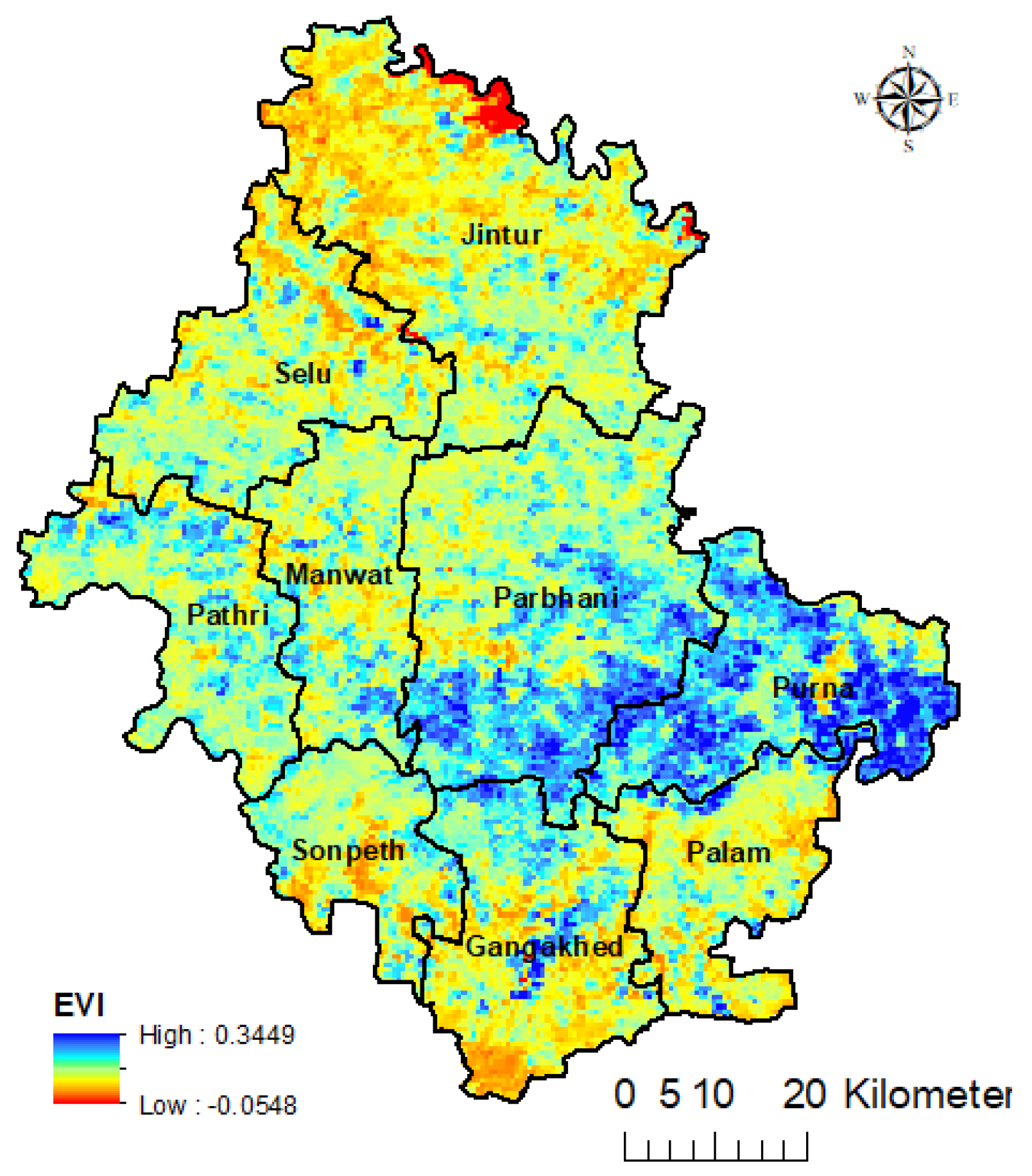

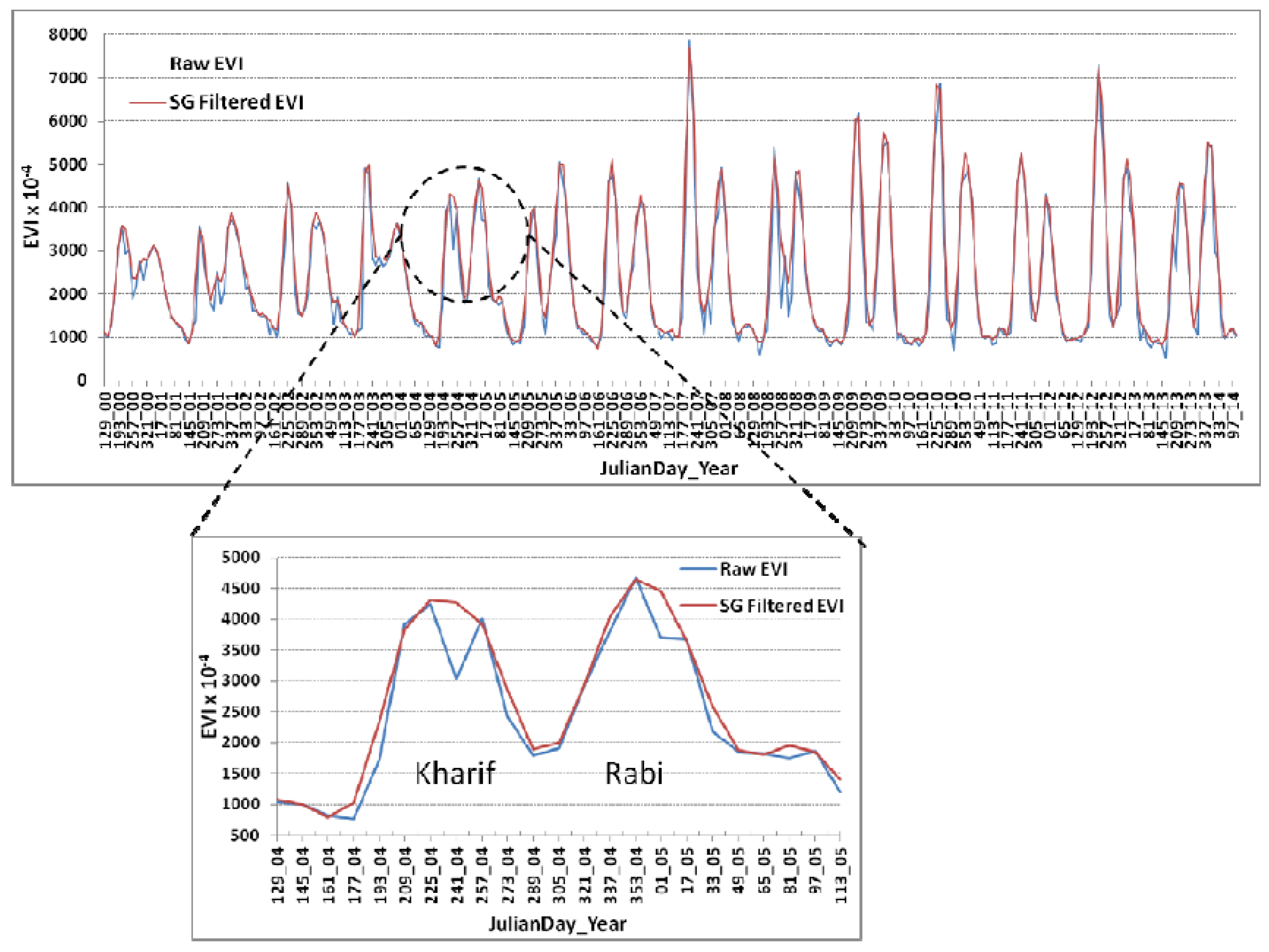
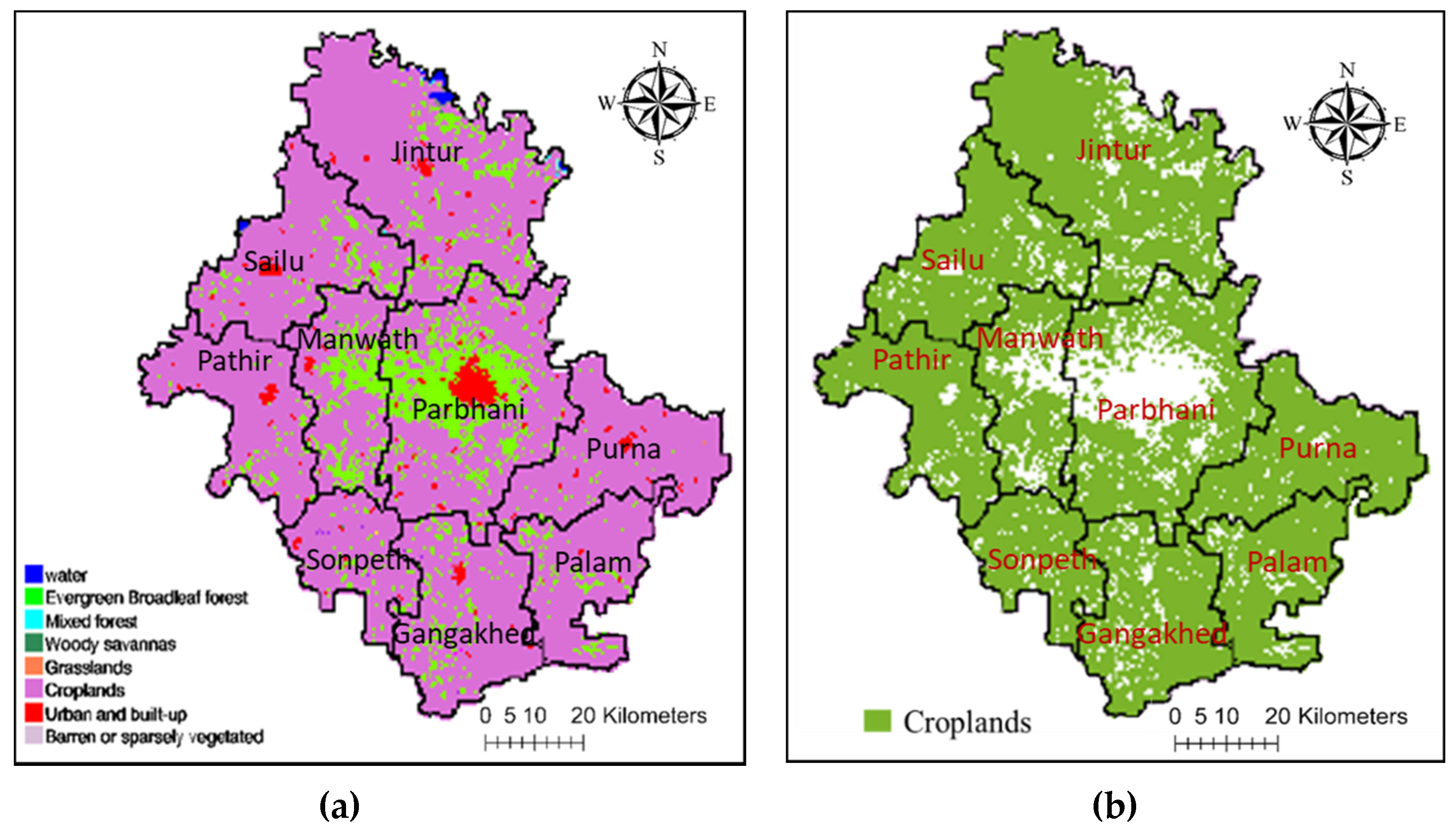
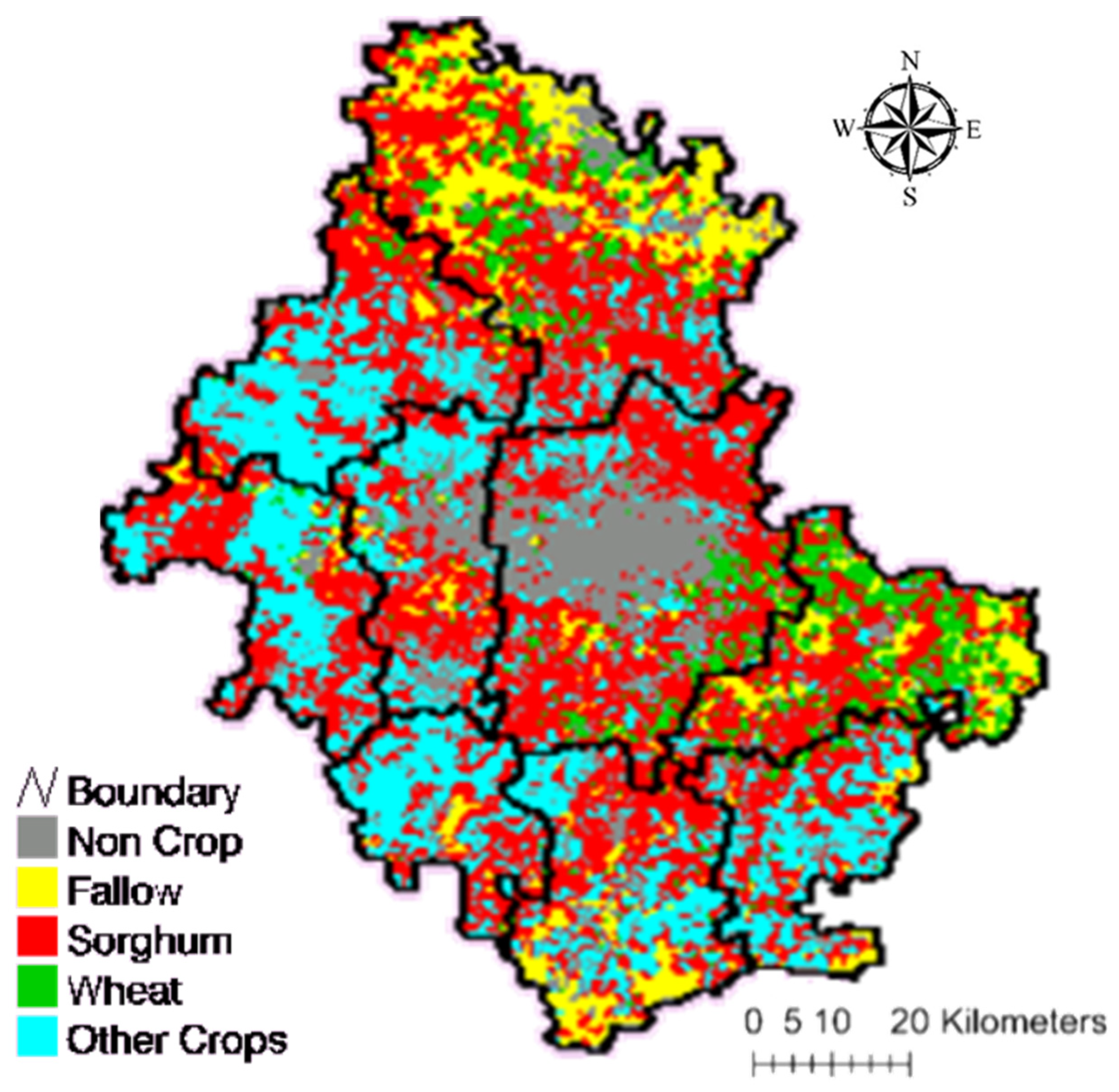
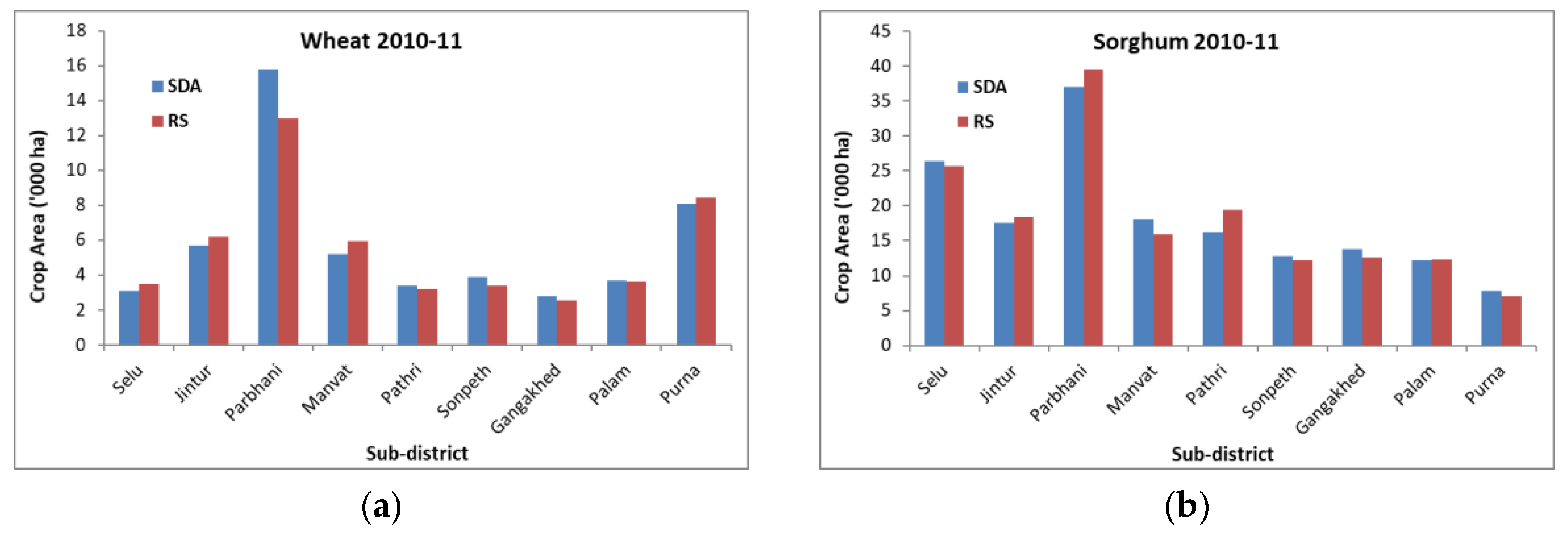
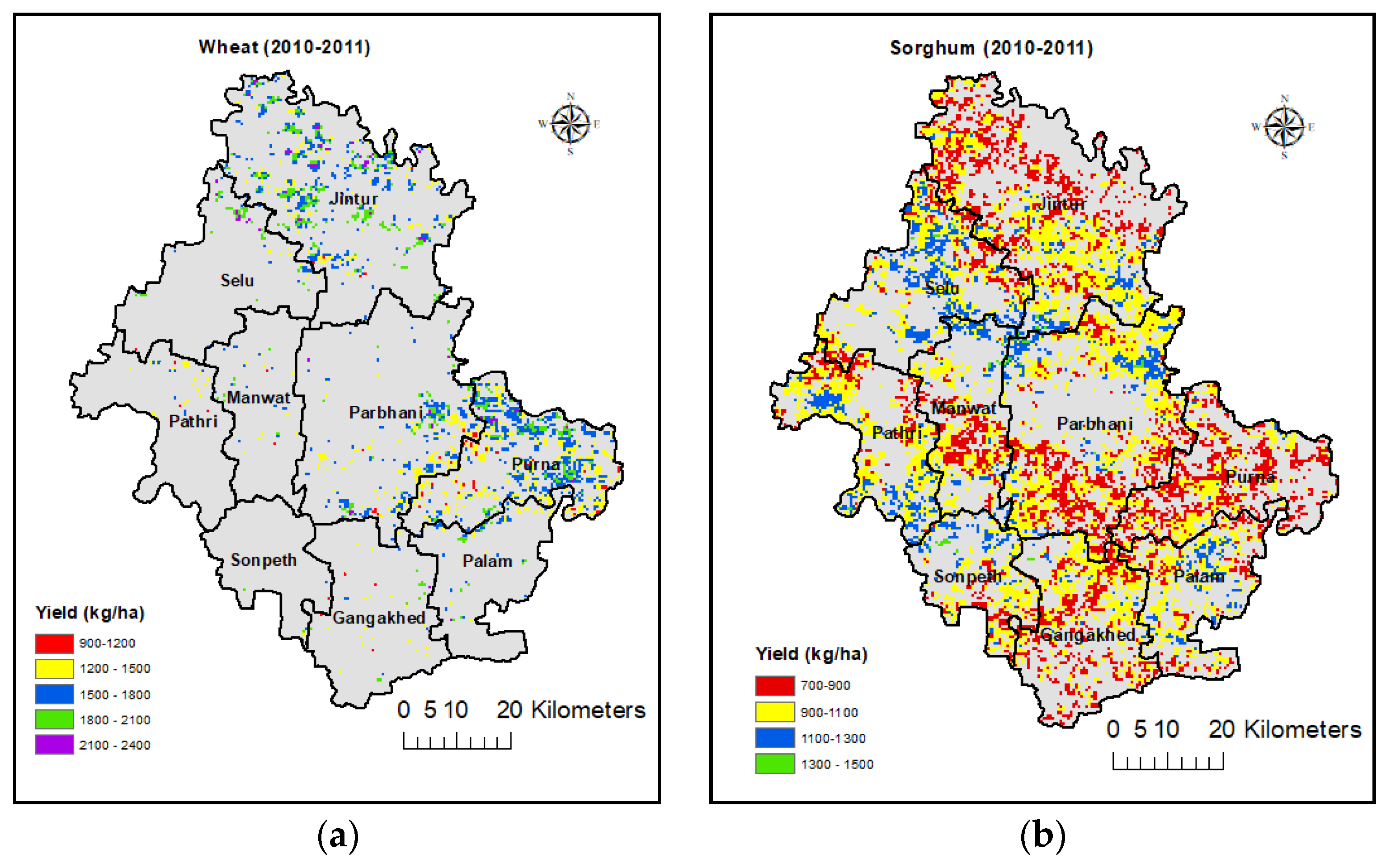
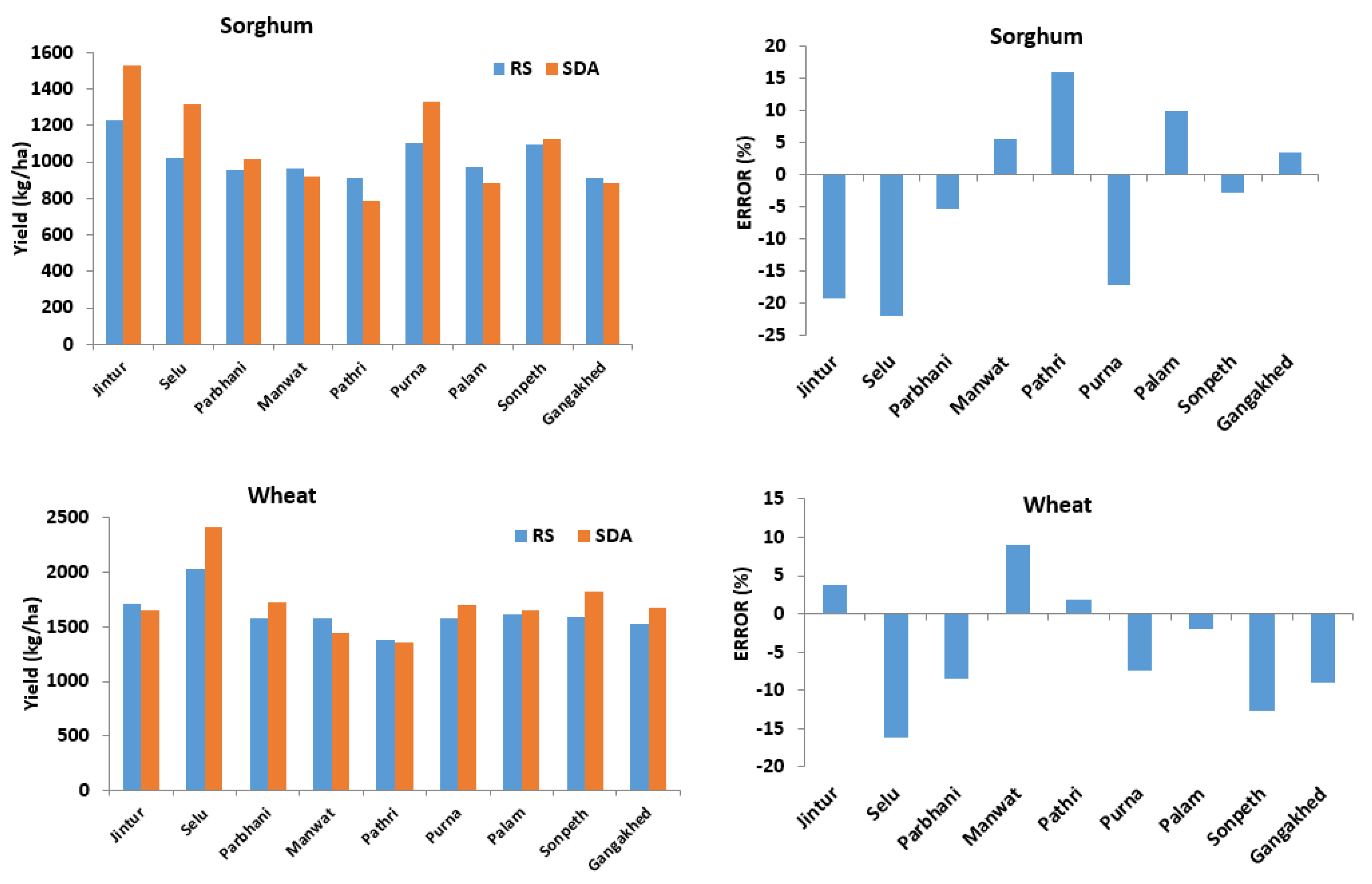
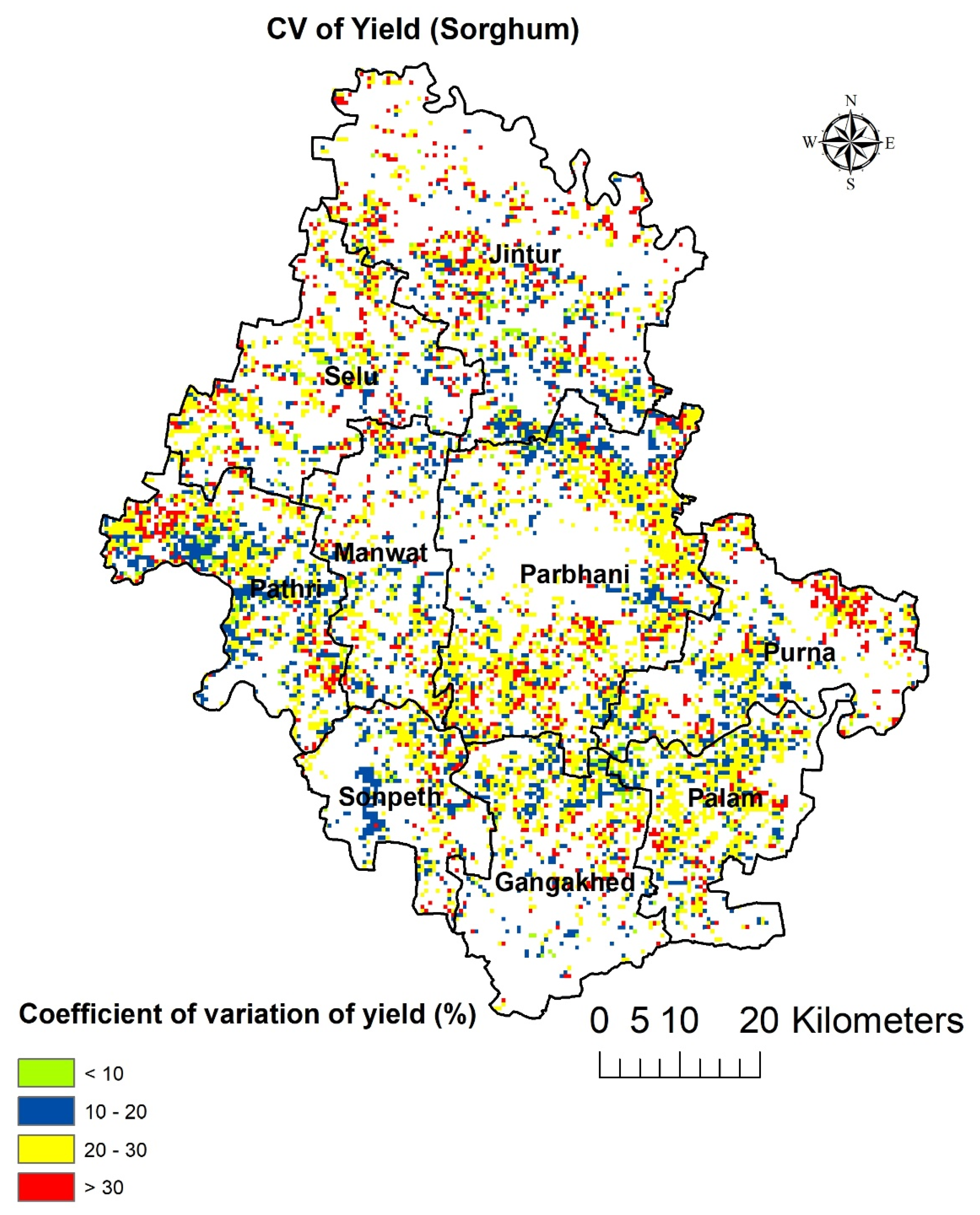
© 2020 by the authors. Licensee MDPI, Basel, Switzerland. This article is an open access article distributed under the terms and conditions of the Creative Commons Attribution (CC BY) license (http://creativecommons.org/licenses/by/4.0/).
Share and Cite
Shirsath, P.B.; Sehgal, V.K.; Aggarwal, P.K. Downscaling Regional Crop Yields to Local Scale Using Remote Sensing. Agriculture 2020, 10, 58. https://doi.org/10.3390/agriculture10030058
Shirsath PB, Sehgal VK, Aggarwal PK. Downscaling Regional Crop Yields to Local Scale Using Remote Sensing. Agriculture. 2020; 10(3):58. https://doi.org/10.3390/agriculture10030058
Chicago/Turabian StyleShirsath, Paresh B., Vinay Kumar Sehgal, and Pramod K. Aggarwal. 2020. "Downscaling Regional Crop Yields to Local Scale Using Remote Sensing" Agriculture 10, no. 3: 58. https://doi.org/10.3390/agriculture10030058
APA StyleShirsath, P. B., Sehgal, V. K., & Aggarwal, P. K. (2020). Downscaling Regional Crop Yields to Local Scale Using Remote Sensing. Agriculture, 10(3), 58. https://doi.org/10.3390/agriculture10030058





